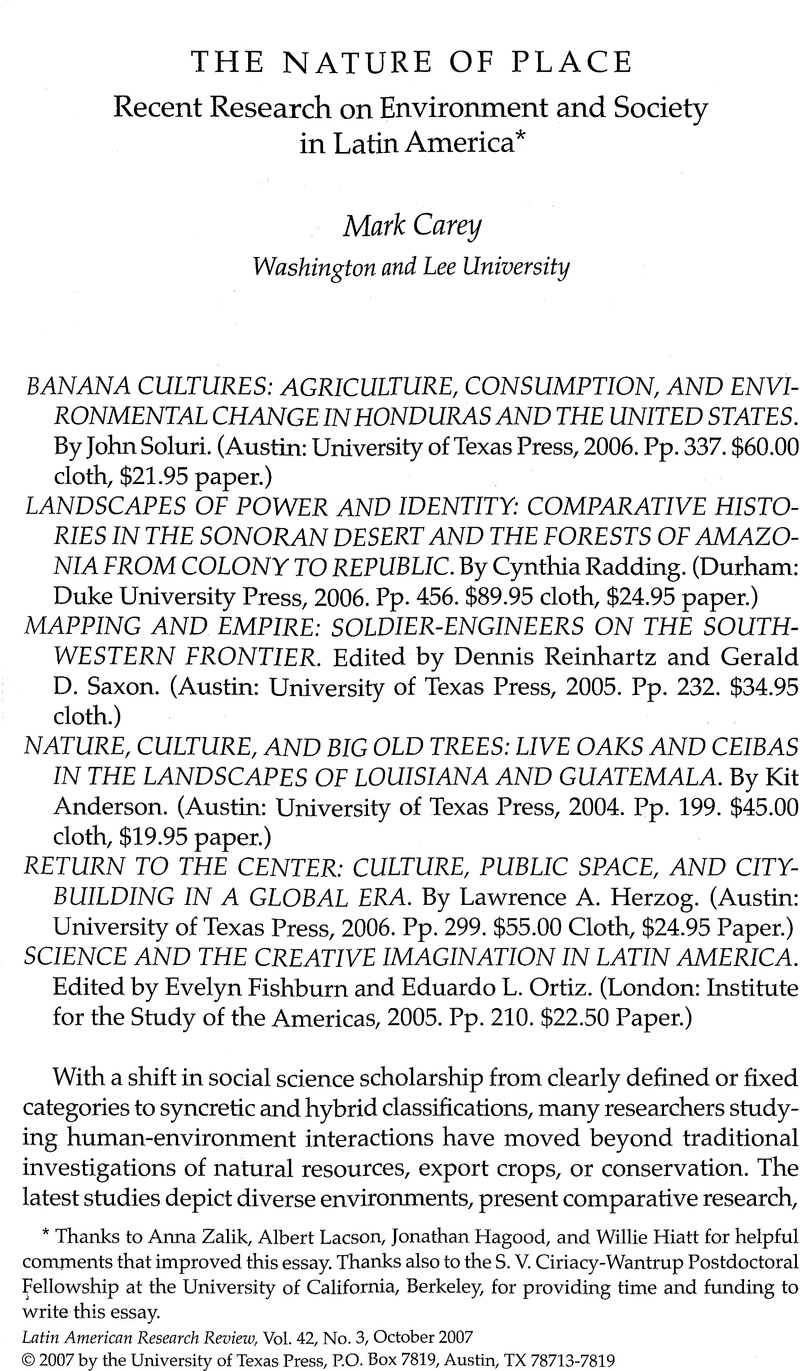Article contents
The Nature of Place: Recent Research on Environment and Society in Latin America
Review products
Published online by Cambridge University Press: 05 September 2022
Abstract

- Type
- Review Essays
- Information
- Copyright
- Copyright © 2007 by the University of Texas Press
Footnotes
Thanks to Anna Zalik, Albert Lacson, Jonathan Hagood, and Willie Hiatt for helpful comments that improved this essay. Thanks also to the S. V. Ciriacy-Wantrup Postdoctoral Fellowship at the University of California, Berkeley, for providing time and funding to write this essay.
References
1. For other recent studies, see Kenneth R. Young, “Nature's Role in Latin American Governance and History.” Latin American Research Review 40, no. 3 (2005): 457–468.
2. These trends are explained in Daniel W. Gade, Nature and Culture in the Andes (Madison: University of Wisconsin Press, 1999); Ted Steinberg, “Down to Earth: Nature, Agency, and Power in History,” The American Historical Review 107, no. 3 (2002): 798–820.
3. For a synthesis of this cultural emphasis, see Richard White, “From Wilderness to Hybrid Landscapes: The Cultural Turn in Environmental History,” The Historian 66, no. 3 (2004): 557–564.
4. For example, Henri Lefebvre, The Production of Space, trans. Donald Nicholson-Smith (Malden, Mass.: Blackwell Publishing, 1991); William Cronon, ed., Uncommon Ground: Rethinking the Human Place in Nature (New York: W.W. Norton and Company, 1996); Akhil Gupta and James Ferguson, “Beyond ‘Culture’: Space, Identity, and the Politics of Difference,” Cultural Anthropology 7, no. 1 (1992): 6–23.
5. Recent critiques of environmental history also suggest that Soluri's work invigorates the field. See Peter Coates, “Emerging from the Wilderness (or, from Redwoods to Bananas): Recent Environmental History in the United States and the Rest of the Americas,” Environment and History 10 (Nov. 2004): 407–438; Matthew W. Klingle, “Spaces of Consumption in Environmental History,” History and Theory 42 (2003): 94–110.
6. Soluri's focus on bananas in Honduras allows him to go into much greater detail than the excellent analysis of agricultural exports from several world regions in Richard P. Tucker, Insatiable Appetite: The United States and the Ecological Degradation of the Tropical World (Berkeley: University of California Press, 2000).
7. Over the last decade, traditional depictions of the U.S. role in Latin America have been shifting to more nuanced views, as represented in Gilbert M. Joseph, Catherine C. LeGrand, and Ricardo D. Salvatore, eds., Close Encounters of Empire: Writing the Cultural History of U.S.-Latin American Relations (Durham, N.C.: Duke University Press, 1998).
8. A number of recent articles have called for greater integration of social and environmental history, including Stephen Mosley, “Common Ground: Integrating Social and Environmental History,” Journal of Social History 39, no. 3 (2006): 915–933; Alan Taylor, “Unnatural Inequalities: Social and Environmental Histories,” Environmental History 1 (1996): 6–19.
9. See, for example, Gastón R. Gordillo, Landscapes of Devils: Tensions of Place and Memory in the Argentinean Chaco (Durham, N.C.: Duke University Press, 2004); Hugh Raffles, In Amazonia: A Natural History (Princeton, N.J.: Princeton University Press, 2002); Candace Slater, Entangled Edens: Visions of the Amazon (Berkeley: University of California Press, 2002).
10. Good examples of this literature on Latin America include D. Graham Burnett, Masters of All They Surveyed: Exploration, Geography, and a British El Dorado (Chicago: University of Chicago Press, 2000); Raymond B. Craib, Cartographic Mexico: A History of State Fixations and Fugitive Landscapes (Durham, N.C.: Duke University Press, 2004).
11. Craib's Cartographic Mexico, for example, shows how nineteenth-century Mexican surveyors played vital roles as intermediaries between local residents and the state.
12. To imagine how an indigenous “map” of the U.S. Southwest might differ from Spanish, U.S., or Mexican maps, see Keith H. Basso, Wisdom Sits in Places: Landscape and Language Among the Western Apache (Albuquerque: University of New Mexico Press, 1996).
13. For example, Nancy Leys Stepan, Picturing Tropical Nature (Ithaca, N.Y.: Cornell University Press, 2001); Laura Briggs, Reproducing Empire: Race, Sex, Science, and U.S. Imperialism in Puerto Rico (Berkeley: University of California Press, 2002); James E. McClellan III, Colonialism and Science: Saint Domingue in the Old Regime (Baltimore: Johns Hopkins University Press, 1992); Gyan Prakash, Another Reason: Science and the Imagination of Modern India (Princeton, N.J.: Princeton University Press, 1999).
14. Stuart McCook, States of Nature: Science, Agriculture, and Environment in the Spanish Caribbean, 1760–1940 (Austin: University of Texas Press, 2002). McCook develops the concept of “creole science” in his work on nation building in Latin America.
15. Romanticizing city plazas of the past does not hold either because Spain and Mexico controlled public spaces in Mexico City since the eighteenth century. See Pamela Voekel, “Peeing on the Palace: Bodily Resistance to Bourbon Reforms,” Journal of Historical Sociology 5, no. 2 (1992): 183–210; Silvia Marina Arrom, Containing the Poor: The Mexico City Poor House, 1774–1871 (Durham, N.C.: Duke University Press, 2000).
16. This is particularly notable for environmental historians, who generally recognized blurred nature-culture boundaries quite late. See Kristin Asdal, “The Problematic Nature of Nature: The Post-Constructivist Challenge to Environmental History,” History and Theory 42 (2003): 60–74; Christian Brannstrom, ed., Territories, Commodities and Knowledges: Latin American Environmental Histories in the Nineteenth and Twentieth Centuries (London: Institute for the Study of the Americas, 2004).
17. George M. Fredrickson, “From Exceptionalism to Variability: Recent Developments in Cross-National Comparative History,” Journal of American History 82, no. 2 (1995): 587–604.
18. For a good recent study that successfully examines intersections of power, social relations, and environment in Ecuador, see Erik Swyngedouw, Social Power and the Urbanization of Water: Flows of Power (New York: Oxford University Press, 2004).
19. Ted Steinberg, “Fertilizing the Tree of Knowledge: Environmental History Comes of Age,” Journal of Interdisciplinary History 35, no. 2 (2004): 265–277; Timothy Mitchell, Rule of Experts: Egypt, Techno-Politics, and Modernity (Berkeley: University of California Press, 2002); Doreen Massey, Space, Place, and Gender (Minneapolis: University of Minnesota Press, 1994); Karl S. Zimmerer and Thomas J. Bassett, eds., Political Ecology: An Integrative Approach to Geography and Environment-Development Studies (New York: The Guilford Press, 2003).
- 1
- Cited by




